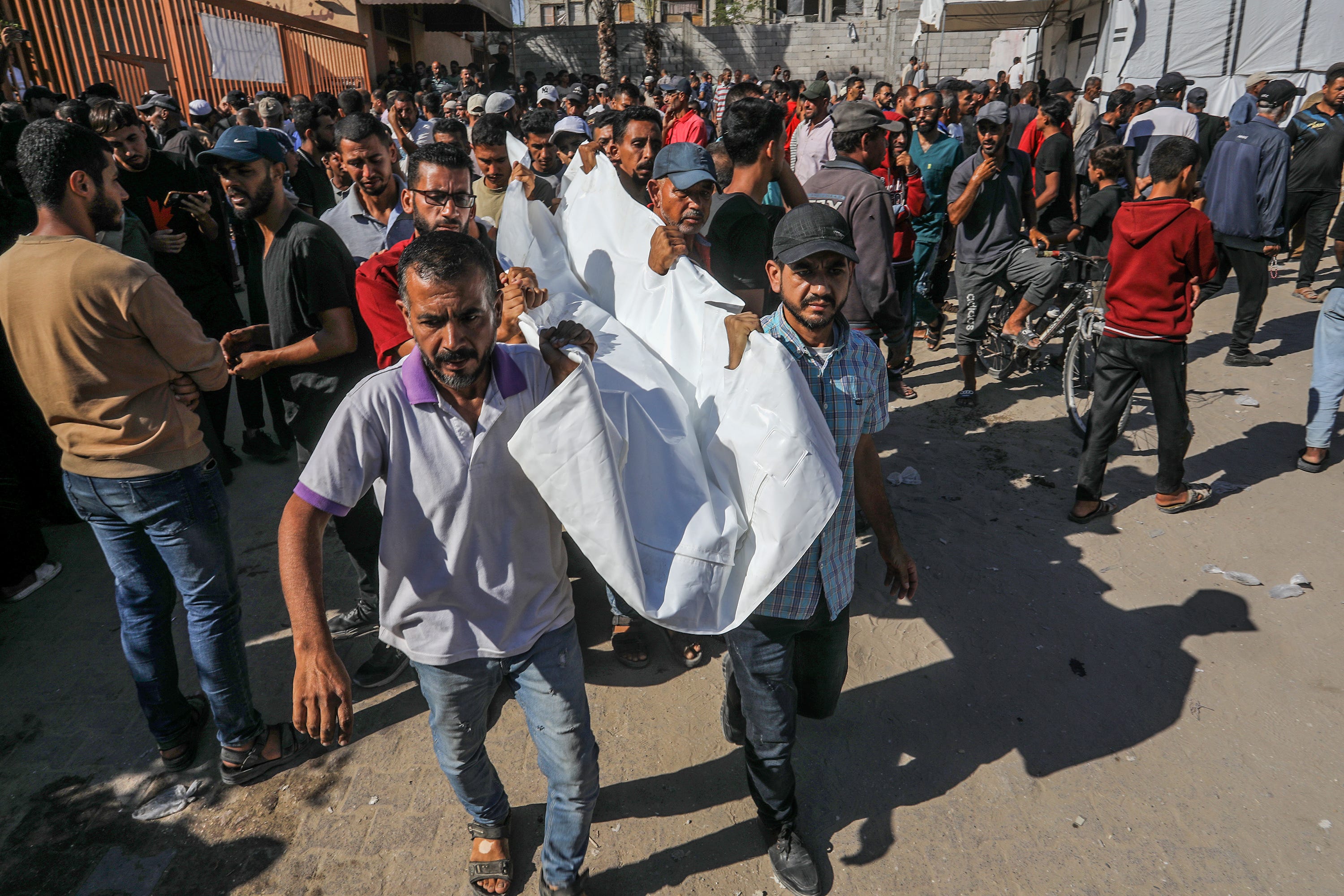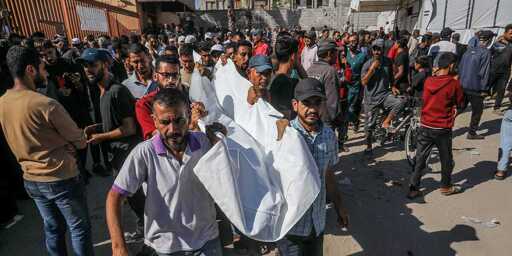 Bodies of Palestinians are brought to Nasser Hospital after an attack on a UN aid supply distribution point in Gaza Strip on July 16, 2025. (Photo by Abed Rahim Khatib/Anadolu via Getty Images).
Bodies of Palestinians are brought to Nasser Hospital after an attack on a UN aid supply distribution point in Gaza Strip on July 16, 2025. (Photo by Abed Rahim Khatib/Anadolu via Getty Images).
Story by Zaki Awadallah and Sharif Abdel Kouddous
KHAN YOUNIS, GAZA—Like hundreds of other young men, Haitham al-Batniji, 28, arrived at the path leading to a so-called “aid distribution” center run by the U.S.- and Israeli-backed group, the Gaza Humanitarian Foundation (GHF), in Khan Younis early on Wednesday morning.
At around 6 a.m., word spread that the site had opened and the crowd ran towards the distribution hub, according to multiple eyewitnesses, located some two to three kilometers (nearly two miles) away. When they arrived, a nightmarish scene unfolded.
The site was closed, though sacks of food could be seen through a narrow and fenced in entrance. Starving and desperate, the crowd squeezed into the area. People were pushed up against the fencing, chest to back, hardly able to breathe. Some fell on the ground and were unable to get up. Then, according to eyewitnesses, GHF guards stationed nearby threw stun grenades and used pepper spray on the crowd, causing mayhem.
“It was a terrifying sight,” al-Batniji told Drop Site News. “The Americans were spraying pepper gas at us; it burns and affects the nervous system of the human body. You just can’t handle it. You’re under pressure. The people are all pushed together and all trampling on each other. There is no air and you feel shortness of breath—everyone wants to go get their food.”
At least 21 people were killed in the incident, according to the Gaza health ministry, and 15 of them died from suffocation due to the gas and the stampede at the site—what the ministry now calls “death traps”—while six others were shot on the road leading to it. Among those killed was al-Batniji’s 22-year-old cousin, Wael. “As soon as he arrived, he fell and was trampled on by everyone.”
“Those behind me started to step forward and push each other. People threw each other onto the fence. The Americans refused to open the gate and left it closed,” Musa al-Quwaider, 23, told Drop Site. “The suffocating people were left lying on the ground, and no one came to them. They didn’t acknowledge them.”
Over 870 Palestinians have been killed in near daily aid massacres since the GHF began operating in Gaza in late May, with Israeli troops and American contractors opening fire on men, women, and children desperately seeking food. The health ministry noted that Wednesday’s incident marked the first time deaths have been recorded as a result of suffocation and a stampede, adding another horrifying dimension to the crisis.
“All the people were pressing all on top of each other to the point that there were children in front of me. [There was] maybe a 14- or 15-year-old boy saying to me, ‘Uncle, please save me,’” Mohammed al-Nams, 28, said, adding that GHF guards nearby refused to open the gate despite the crush of people. “I was surrounded for about 15 to 20 minutes, and we couldn’t catch our breath.”
Al-Nams said it was at that moment when the guards gassed the crowd. “It’s as if they meant to kill you. They meant to suffocate you.”
Medics at Nasser hospital found clear traces of gas inhalation on the victims’ bodies. “When these martyrs arrived at the Nasser Medical Complex morgue and were examined by the forensic doctor, traces of redness were found in eyes, dilated pupils, and the effects of the gas, along with sweating and suffocation, were all strong evidence that there were cases of gas poisoning and suffocation,” Dr. Marwan Al-Hams, director of field hospitals in Gaza, told Drop Site. “We received a report from the director of forensic medicine in Khan Younis, and he said that the cases were suffocation because of gas and because of the stampede.”
For the first time, the GHF released a statement acknowledging mass deaths at one of its sites, but it claimed, without evidence, that “agitators in the crowd” caused the stampede.
Drop Site News is reader-supported. Consider becoming a free or paid subscriber.
GHF operates four so-called “aid distribution” sites in Gaza, three of which are in militarized zones in the far south of Gaza and another in a militarized zone in central Gaza. Previously, the UN distributed aid through a coordinated delivery system that featured around 400 locations across Gaza. The Israeli- and U.S.-backed GHF system that replaced it has been criticized by the UN and hundreds of international NGOs as the weaponization of aid and part of an Israeli plan to displace Palestinians in Gaza to a small, concentrated zone in the south.
Palestinians often have to travel for hours to reach the GHF sites, while the organization has issued confusing and conflicting announcements for when the hubs are open. In a recent report, the UK-based research group Forensic Architecture found that the average duration of openings at GHF stations was just 23 minutes. “In 23% of cases we examined, GHF stations were announced to be closed again even before the previously announced opening time,” the report said. “60% of the announcements on GHF’s Facebook page were published less than one hour before the stations opened. Given that many civilians need to walk for up to three hours to reach the stations, it is unlikely they could arrive in time. As a result, civilians are queuing over night and some are moving their tents closer to GHF stations, contributing to an ongoing displacement of Gaza’s civilian population southwards, and towards militarized areas.”
Since Israel imposed a full-spectrum siege on March 2, the entire population of Gaza has been driven to the brink of famine and nearly 70 children have died as a result of acute malnutrition.
Despite the daily killing of people seeking aid at, or near, GHF sites, starving Palestinians say they have no choice but to risk their lives and go to try and get food. “I know that the place is dangerous, but there is nothing I can do,” Al-Batniji said. “What am I supposed to eat? How am I supposed to drink? How am I supposed to bake bread? How am I supposed to provide for my family? No water, no nothing.”
As Palestinians in Gaza await any word on the “ceasefire” negotiations, the ongoing emergency situation has only become increasingly dire for those caught between the “death traps” laid by the GHF and imminent starvation.
“We are approaching a moment when hunger is no longer just pain, but transforms into a killer roaming the alleys and shelters, causing people to collapse in groups in the streets, in their homes, and among the ruins of tents—simply because they can’t find anything to eat,” Eyad Amawi, a representative of the Gaza Relief Committee and a coordinator for local NGOs, told Drop Site. “We are on the brink of a collective catastrophe. Death in Gaza today is no longer caused only by bombs. Hunger has become a silent weapon claiming lives without a sound—a form of slow, deliberate extermination.”
Drop Site News Middle East Research Fellow Jawa Ahmad contributed to this report.
From Drop Site News via this RSS feed


